Menu
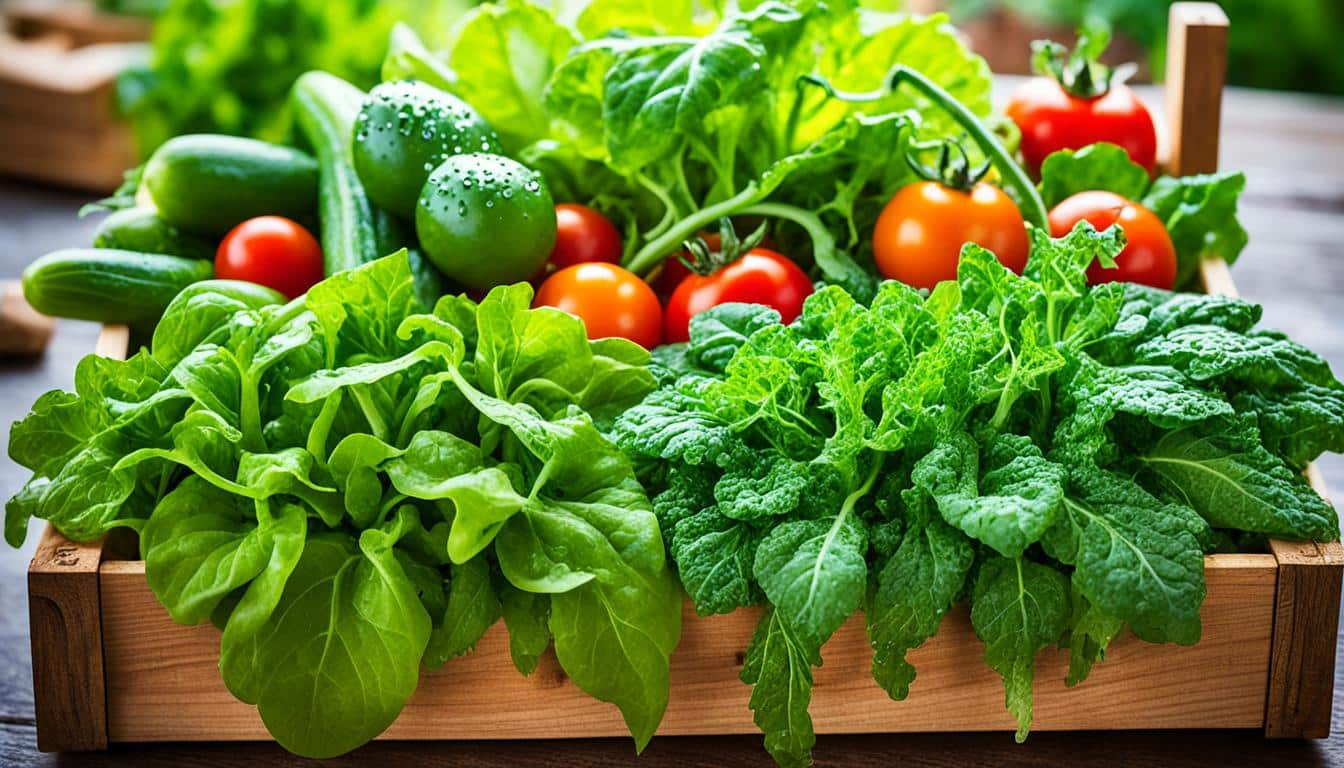
Hydroponically-grown food often has more essential vitamins and minerals. This is in comparison to organic food grown in soil. More and more, people favour organic hydroponics for sustainable farming. It meets both the needs for eco-friendliness and nutrient-packed foods.
Organic hydroponics is a modern way to grow food without soil. It uses water with nutrients to feed plants. This method meets the growing demand for environmentally friendly and nutritious food. It also cuts out harmful chemicals, keeping the food safe and healthy.
Using this method lessens harm to the planet. It grows food in a pure, sustainable way. Plus, it removes the risk of pesticides and harmful minerals in food.
Organic hydroponics is a mix of new farming methods and green practices. It grows plants without soil, but uses nutrients in water. This way of farming boosts crop growth in places where normal farming struggles.
Hydroponics lets plants grow in a water solution without soil. It saves a lot of water, needing only a fraction compared to traditional farming. Because it doesn’t need soil, hydroponics works in small or unusual spaces for farming.
Organic hydroponics is key for creating food in a sustainable way. Some crops in this method got an ‘organic’ label in 2017, showing its value. It also cuts waste by using natural leftovers for nutrients. This helps with pollution from water and soil in standard farming.
Growing with organic hydroponics proves it can be done. Yet, it needs careful attention to what plants need for food. Using only natural fertilisers is critical to avoid harming plants. But, it can be hard work because of the energy used by machines in this farming.
Still, many people are drawn to hydroponics because it offers healthy food made in an earth-friendly way. It’s a hopeful way to farm in the future that looks very promising.
Hydroponic farming is a way to grow plants without soil. It has many advantages over traditional farming. One big benefit is using a lot less water. Traditional farming uses most of the world’s water, but hydroponics needs 90% less. This makes farming much more efficient.
Traditional farming needs lots of land. Hydroponics needs up to 99% less land. This makes it perfect for cities or places with little land. Also, plants grow better in hydroponic systems. They get just the right nutrients, making them healthier to eat.
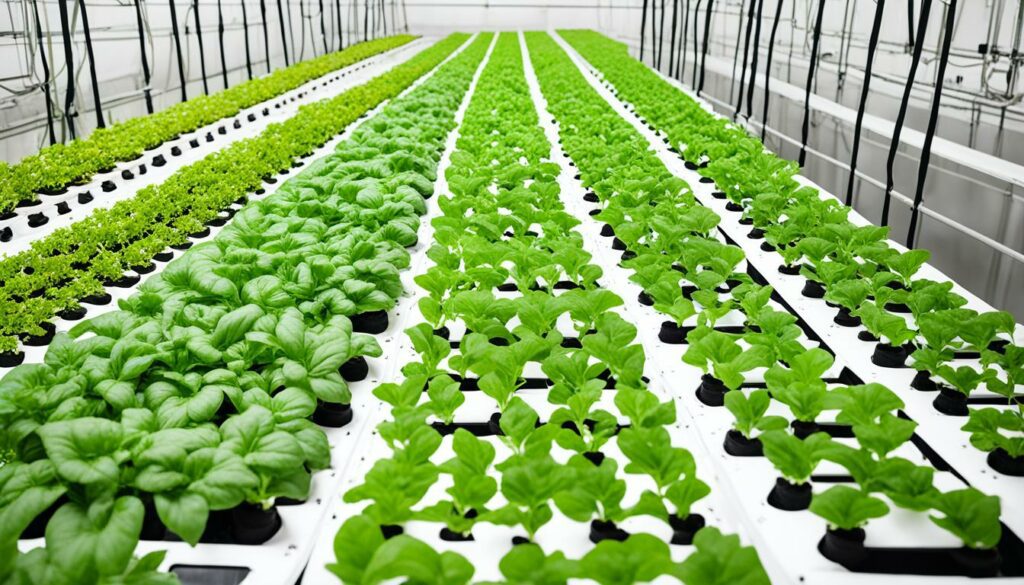
One great thing about hydroponics is you can grow plants in any weather. So, you always get fresh, tasty crops. Hydroponics also gets rid of diseases in the soil. This is good for the environment.
Hydroponics also uses special technology to make plants grow even better. It uses LED lights that help plants use energy more efficiently. This means you get top-quality food that’s good for you.
Yet, there are some challenges. Getting started can be expensive. And you need to keep an eye on the technology. But the benefits are worth it. Hydroponics can produce a lot, save resources, and grow healthy food.
Organic hydroponics is a big step towards farming that happens with the environment in mind. It uses the latest techniques to tackle important environmental issues. By not using soil, it helps to save and protect the soil. This means there’s less erosion, which is vital for our planet’s health. Also, it uses less water, which is great for places where water is scarce.
Normally, farming causes problems like soil damage and erosion. This lowers the ground’s ability to grow crops well over time. Hydroponics doesn’t need soil, so it doesn’t contribute to these issues. It’s a big win for the environment. Using hydroponics allows us to farm using only a fraction of the land traditional farming does. This protects more land and still grows enough food.
With water becoming scarcer, it’s crucial we use water wisely in farming. Hydroponics needs just a fraction of the water used in traditional farming. It’s all thanks to a system that recycles water and nutrients. This way, it grows plants very efficiently without draining water resources.
Managing nutrients is key in farming. Organic hydroponics does this in a way that’s good for the environment. It uses systems that keep reusing nutrients, making sure plants get what they need without overloading them with nitrates. For example, lettuce grown this way has much lower nitrate levels than when grown traditionally. There are different hydroponic styles, like the nutrient film technique, deep water culture, and aeroponics. Each offers unique ways to handle nutrients. This method is essential for eco-friendly farming.
Here’s a look at how hydroponic farming compares to traditional farming:
| Aspect | Hydroponic Farming | Traditional Farming |
|---|---|---|
| Land Usage | 20% of the land | 100% of the land |
| Water Consumption | 10% of the water | 100% of the water |
| Need for Pesticides | Significantly reduced | High |
| Need for Herbicides | Eliminated | Required |
| Nutrient Management | Organic nutrients with reduced nitrate levels | Synthetic fertilizers |
Conventional and organic hydroponics differ in the nutrients they use. Organic hydroponics use natural sources for nutrients. For convention methods, mostly, it’s synthetic minerals. This choice is key for sustainable practices and meets organic standards aimed at copying nature.
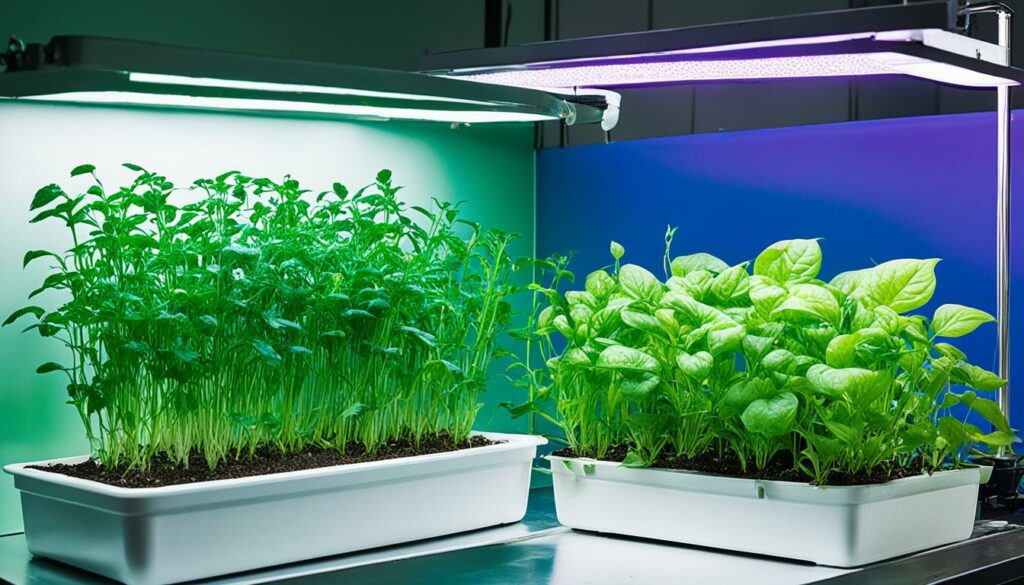
Organic hydroponics need a lot of knowledge and training. It’s more about watching things grow than traditional farming, and needs less work and tools.
Hydroponics stands out by using less water and letting you grow more in the same space.
More and more growers are interested in organic hydroponic farming. This interest marks a move towards sustainable methods. A 12,000 square foot greenhouse is used to compare five different systems. These include flood-and-drain racks, NFT systems, floating rafts, and a ZipGrow Tower setup.
Organic hydroponics are secure in terms of nutrients. Those who use Pre-Empt organic fertilizers keep their nutrient tanks up to five months without a flush. But, there are hurdles. This includes managing citric acid and keeping a check on sodium levels.
Maintaining EC levels is vital in organic hydroponics. It helps to know the salt amounts in water. For instance, calcium levels in crops grown organically are usually lower than in conventional growing.
Hydroponic gardening has various systems to grow plants without soil. Each system focuses on different needs for plant growth. This ensures they work well in different environments. The main types are aggregate systems, liquid systems, and aquaponics.
In aggregate hydroponics, plants grow on solid materials. These can include perlite, vermiculite, or rockwool. These materials hold water and nutrients well, which is great for plants needing a steady base. The Ebb and Flow system is common in this method. It floods and drains the plant base. This process, which can be repeated a few times a day, helps the plants take in water and nutrients better.
Liquid systems put roots directly into water. The NFT system (Nutrient Film Technique) and aeroponics are examples. NFT is used a lot in commercial setups because it’s efficient and boosts yield. Without soil blocking them, roots drink up nutrients quickly. Aeroponics, developed by NASA, sprays roots with mist. This can make plants grow up to 50% faster.
Aquaponics combines hydroponics with fish farming. Fish waste provides food for the plants. In return, the plants clean the water for the fish. This method is fantastic for saving water and eliminating waste. It’s a model of eco-friendly farming.
| System | Benefits | Typical Usage |
|---|---|---|
| Aggregate Hydroponics | Stable root support, effective moisture retention | Vegetables, flowers, and herbs |
| Liquid Hydroponic Solutions | Faster plant maturity, direct nutrient uptake | Leafy greens and commercial crops |
| Aquaponics Integration | Zero waste, sustainable nutrient cycle | Fish and various plants |
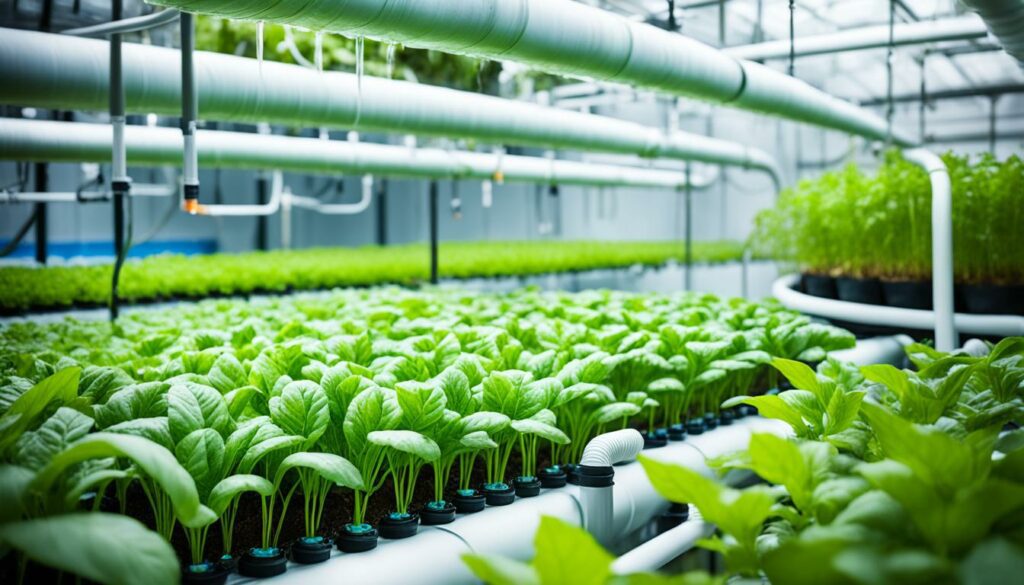
For great growth in organic hydroponics, it’s all about the solutions’ quality. These nutrients are key for plant health. They provide what plants need for strong growth. Let’s talk about the main elements in these solutions. And, we’ll see how organic and synthetic ways differ.
Hydroponic setups depend on many nutrient solutions for essential elements. An ideal solution has Nitrogen, Phosphorus, and Potassium. It also has micronutrients like Calcium, Magnesium, and Iron. The mix must meet the plant’s specific needs for a good, steady growth.
Organic fertilizers play a big role, using leftovers creatively. These homemade mixtures could be from breaking down organic waste, like fish emulsions or compost teas. They show that healthy growth can happen without manmade stuff.
| Component | Function | Source |
|---|---|---|
| Nitrogen | Leaf and stem growth | Fish Emulsions, Organic Waste |
| Phosphorus | Root and flower development | Bone Meal, Organic Teas |
| Potassium | Disease resistance, overall plant health | Wood Ashes, Compost |
| Calcium | Cell wall structure | Lime, Eggshells |
| Magnesium | Chlorophyll production | Epsom Salts, Compost Teas |
The difference between organic and synthetic nutrients matters in organic hydroponics. Organic ones come from natural places and keep things green. These methods support a healthy environment.
In contrast, synthetic nutrients are made in labs for exact nutrient levels. They efficiently feed plants but might not be best for the planet. The debate over what’s better shows how important natural and eco-friendly methods are.
In 2017, the US changed its stance, letting some hydroponic and aquaponic crops get an organic tag. However, aeroponics was left out. This shows more acceptance for organic hydroponic farming.
Choosing between organic and synthetic is about thinking long-term. Using things like fish emulsions for nitrogen, bone meal for phosphorus, and wood ashes for potassium, we can grow strong. And we help the environment too.
Organic hydroponics offer many benefits. But there are also challenges to face. Keeping the right nutrient balance without soil brings some issues. It’s not easy and needs careful attention from knowledgeable growers.
The issue around organic certification is complex too. The Ninth Circuit Court of Appeals did say the USDA could certify these crops as organic in 2022. However, the debate about whether they truly are organic continues.
This big argument goes back to what the National Organic Standards Board (NOSB) recommended. They were against certifying these crops. But, there’s still no clear, standard definition. So, getting certified is hard for hydroponic growers.
Here’s a quick look at the main issues:
| Aspect | Organic Hydroponics | Conventional Hydroponics |
|---|---|---|
| Fertiliser Options | More Limited | Extensive Variety |
| Pest Management | Slower, Organic Methods | Faster, Conventional Pesticides |
| Certification | Debated and Challenging | Generally Accepted |
| Costs of Materials | Generally Higher | Relatively Lower |
It’s really important to find solutions for these challenges. Doing so will help organic hydroponics grow. Tackling system management issues and finding a clear way to certify these crops is key. With efforts, we can make organic hydroponics a strong and eco-friendly choice for agriculture.
The question of whether soilless systems can be certified organic, like hydroponics, sparks much debate among farmers. The USDA National Organic Program (USDA NOP) has made a firm decision. This issue has led to many talks about the rules and court battles.
Currently, the USDA NOP allows hydroponic methods to get an organic certification. This decision has been fought over in court and backed several times. In 2019, the USDA rejected a petition pushing to stop hydroponics from becoming organic.
A legal battle followed in 2020 where a group of organic farms and others took on the issue. The struggle resulted in a district court ruling for the USDA in March 2021. The Ninth Circuit Court of Appeals agreed on this in September 2022.
| Year | Event |
|---|---|
| 2019 | USDA denied CFS petition to prohibit organic certification of hydroponics |
| 2020 | CFS sued USDA |
| 2021 | Northern District of California ruled in favour of USDA |
| 2022 | Ninth Circuit Court of Appeals upheld ruling |
Even with these court decisions, problems with the rules persist. The issue is whether soilless methods meet the true organic farming principles. The NOSB traditionally argues against certifying soilless methods. They say organic farming rests on healthy soil, which is hard to achieve without actual soil.
Many in the organic farming world say giving organic labels to hydroponics goes against its core beliefs. They fear it might water down what organic truly means. Everyone agrees on the need for clear, consistent rules for giving out organic certifications.
The hydroponic market in the U.S. is growing fast, more than aquaponics and aeroponics. It’s important to have strict rules for organic labels to keep people’s trust. Looking ahead, we must explore how to address the challenges and chances of soilless systems to shape the future of organic farming.
By 2050, our planet will likely home 9.8 billion people, with 68% living in cities. This will challenge us to find new ways to grow food. Current agricultural methods need significant upgrading to match the higher demand for food and deal with water and land waste. Organic hydroponics is a smart answer, especially in cities where we lack space and resources.
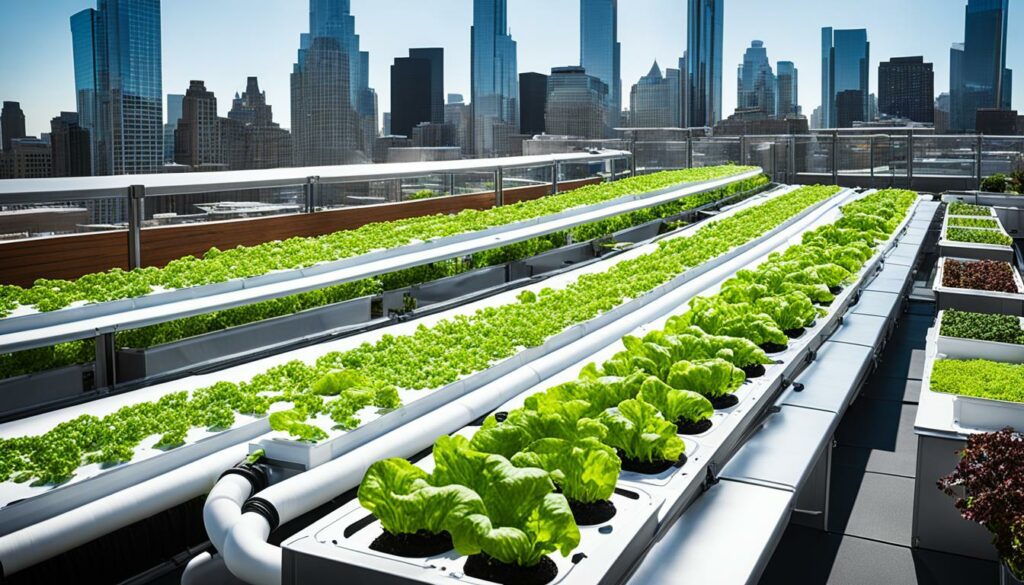
Hydroponic systems are perfect for cities due to their flexibility. They easily fit into urban spots like rooftops, balconies, and indoors, allowing anyone to take part in urban agriculture. This local growing means less need to bring in food from afar. Also, hydroponics uses much less water and almost no land compared to traditional methods.
Community Supported Agriculture (CSA) allows for consistent access to fresh, local food. By adding hydroponic systems, CSAs can boost year-round production. This benefits the local economy and brings people closer to farming. Hydroponics’ efficiency makes this model even better, using fewer resources and increasing food output.
This mix of hydroponics and community farming is a strong step towards better city agriculture.
| Aspect | Traditional Agriculture | Hydroponic Agriculture |
|---|---|---|
| Water Usage | High, up to 70% of water usage | Low, up to 90% less water used |
| Land Requirements | Extensive, 38% of non-frozen land used | Minimal, can be reduced by 90-99% |
| Freshness of Produce | Variable, dependent on distance and transport | High, locally grown with shorter transport times |
| Environmental Impact | High, including deforestation and biodiversity loss | Low, reduced land use and water savings |
| Productivity | Moderate, affected by weather and soil conditions | High, controlled environments increase yields |
Area 2 Farms is a standout example of a successful organic hydroponic farm. It is based in Arlington, Virginia. The farm uses 3,600 square feet but grows vertically on eight levels. As a result, it has over 6,000 square feet of growing space. Innovations like this allow the farm to serve 400-600 people a week.
The farm is serious about being organic. They recycle plant debris and substrate by vermicomposting for three weeks. This practise boosts soil quality. The use of Terra Bella microbial inoculant helps create a strong, organic environment.
They also use advanced lighting called Current Arize Factor LED lights. These lights cover more area and need fewer fixtures. This choice shows their efforts in being efficient and forward-thinking.
Some big names, like Patagonia and Nature’s Path, are against hydroponics in organic farming. They question if the USDA should allow it. They believe that hydroponics might be more scalable but can reduce options for soil-grown food.
Despite the debate, Area 2 Farms is focused. They use Pre-Empt organic fertiliser to grow various crops. The farm’s aim is to attract 400 CSA members to become profitable. Their direct sales approach proves that indoor farming can succeed economically.
Jeff Baras, the founder, brings his knowledge of greenhouse farming to the table. He also collaborates with Hort Americas. Together, they make key decisions, highlighting the need for shared expertise in organic hydroponics.
| Statistic | Details |
|---|---|
| Non-GMO Policy | 100% non-GMO |
| CSA Goal | 400 members |
| Current CSA Members | Around 200 |
| Floor Space | 3,600 square feet |
| Vertical Growing Space | Over 6,000 square feet |
| LED Light Efficiency | One fixture replaces three 4-foot Link fixtures |
| Substrate Recycling | Vermicomposting for three weeks |
Starting your hydroponic garden is exciting. It lets us grow organic produce without soil in a sustainable way. To make your garden thrive, plan the setup, maintain it well, and choose the best plants. Follow these steps to succeed.
First, pick the right hydroponic system. For beginners, easy options like wick or water culture systems are great. You’ll need things like reservoirs and growing trays for each system. Also, pick up some seedlings to get started.
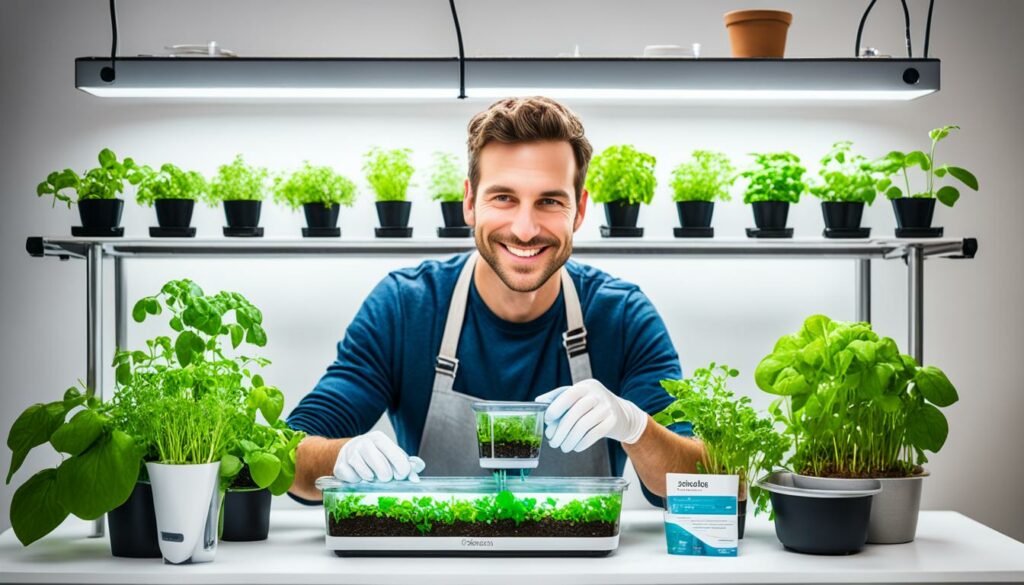
Don’t forget the tools, like drills, and supplies, including hydroponic fertilisers. For indoor gardens, make sure you have enough light and good airflow. These are key to healthy plant growth.
Keeping your garden in good shape is important. Check the plants often to make sure they’re healthy. It’s key to regularly look at the water’s nutrient levels and balance the pH. The right light, and controlling the temperature and humidity, keep things perfect for growth.
Since hydroponic systems don’t use soil, there are no weeds. But, watch out for diseases that water can carry. Clean your equipment every so often to avoid clogs and keep the plants happy.
Choosing the best plants for your hydroponic garden is critical. Things like lettuce and basil grow well in these systems. They use nutrients effectively and are strong, too.
For winter gardening, pick crops that don’t fruit, such as leafy greens. They do well inside. The wick system is great for plants that don’t need much water, like microgreens. Other systems let you grow a wider variety of greens and herbs.
| System Type | Suitable Plants |
|---|---|
| Wick | Microgreens, herbs, peppers |
| Water Culture | Leaf lettuce |
| Ebb and Flow | Kale, basil, lettuce |
To sum up, starting a hydroponic garden needs careful planning and upkeep. Picking the right plants is also key. Do these well, and you’ll enjoy the benefits of fresh, organic produce all year round.
Hydroponically grown crops and soil-grown ones show many differences. The main one is the speed at which they grow. Crops grown hydroponically grow around 40-50% faster. They can do this because the growers closely control the conditions. This includes the pH of the water, nutrient levels, and the amount of light and heat the plants get.
Hydroponics also lead to bigger harvests, up to 25% more. This is because plants get a steady supply of nutrients in the water. And the growing environment is carefully managed. Hydroponic farms are also much better for the planet. They use 90% less water than traditional farming. This is thanks to a smart design that recycles water.
However, soil-grown crops can be richer in some nutrients like calcium and magnesium. This is because the soil naturally contains these elements. Still, hydroponic crops win when it comes to overall nutritional value. They have 50% more vitamins. This is because farmers can adjust the water’s chemistry to help plants grow healthier.
The table below shows the main differences between hydroponically and soil-grown crops:
| Aspect | Hydroponically Grown Crops | Soil-Grown Agricultural Produce |
|---|---|---|
| Growth Rate | 40-50% Faster | Slower |
| Yield | 20-25% Higher | Lower |
| Water Usage | 90% Less | High |
| Nutritional Value | 50% More Vitamins | Higher Micronutrients (e.g., Calcium, Magnesium) |
| Control Over Conditions | Precise | Variable |
The choice between hydroponically grown and soil-grown crops comes down to what you value. For big farms wanting to be efficient and produce a lot, hydroponics are better. However, small-scale growers might prefer traditional soil farming. It’s simpler and doesn’t need as much special equipment.
To get the best results in organic hydroponics, you need to be very careful. It’s key to look after the lighting, keep the temperature steady, manage pests and diseases, and watch the nutrients. This helps your plants grow more and gives bigger yields.
From what we’ve seen, the right lighting and temperature really help the plants. Using top-notch LED lights that act like the sun can up photosynthesis. This leads to more crops. Kept between 18°C and 24°C, most plants do well.
A stable environment also lessens plant stress and cuts down diseases. That’s why using systems to control light and temperature is smart. They make your yield better.
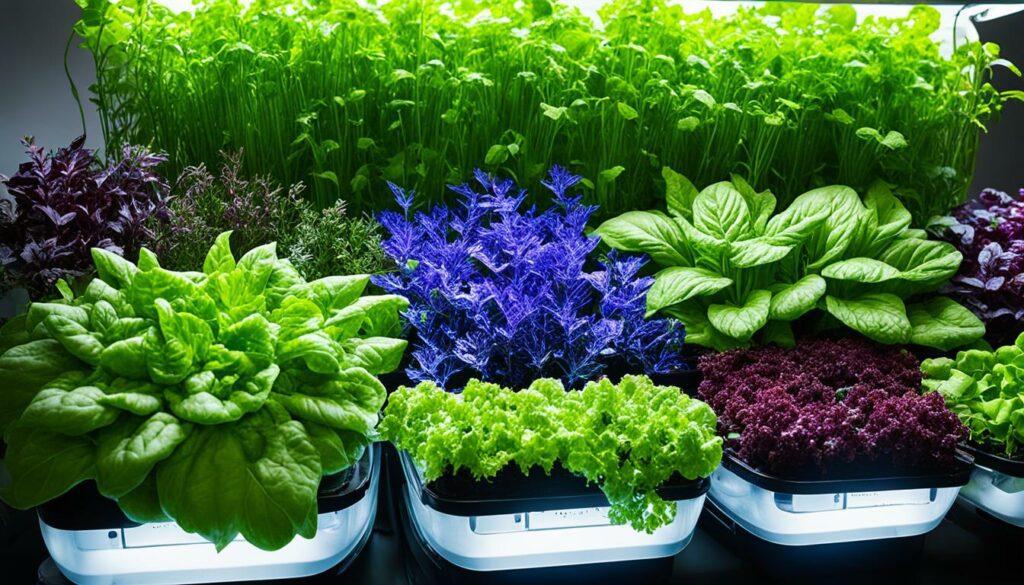
Dealing with pests in hydroponics can be simpler than in soil. But, you still have to stay sharp. Check your plants often to catch pests early. Using IPM can stop pests from getting out of hand.
For organic hydroponics, you can bring in helpful insects like ladybirds or lacewings. Also, choose organic sprays to keep away pests without the bad stuff. Don’t forget to clean your hydroponic gear regularly to stop diseases.
Watching the nutrient levels is really important in hydroponics. Regular checks on your plant food make sure plants get what they need. Things like Nitrogen, Phosphorus, and Potassium are crucial. Too little or too much can harm plants and lower your yield.
Using meters for pH and EC of your plant food can keep nutrients right. Adjusting based on these meters makes sure your plants are in their best. This care leads to strong growth and more crops.
Many people think highly of organic hydroponic products. They like that these items have a low impact on the environment and provide healthy food. This good view comes in part from the USDA certified organic seal, which brings trust. Because of this, consumers are happy to pay more for organic hydroponic produce.
Yet, not everyone trusts the ‘organic’ tag for hydroponic farming. They doubt it because hydroponics don’t use soil. This doubt gets worse because it’s hard to get organic fertilisers and control pests in hydroponic systems. Plus, organic hydroponics might produce less than traditional farming, making some people unsure about its value.
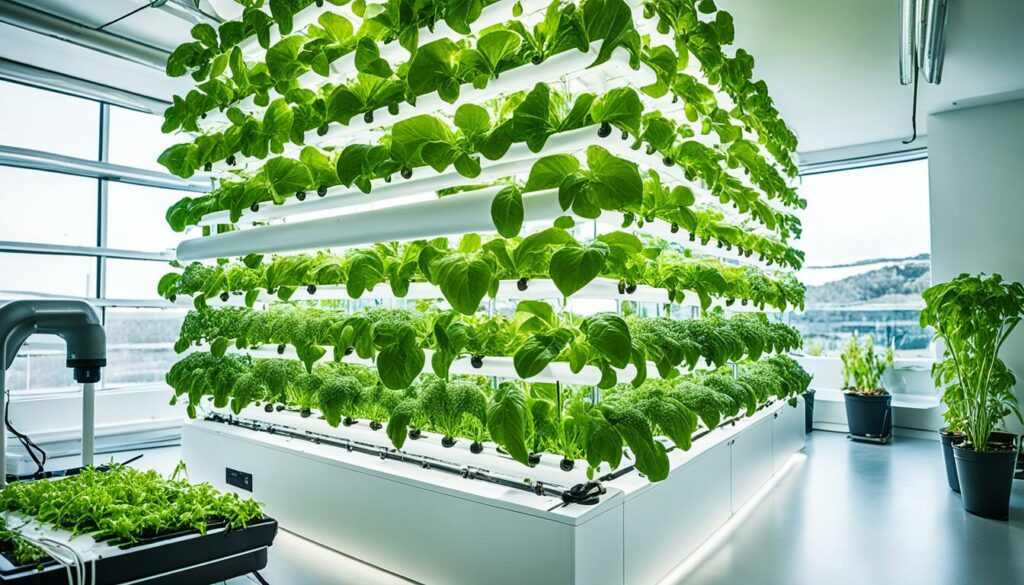
| Organic Hydroponics | Conventional Hydroponics | |
|---|---|---|
| Environmental Impact | Promotes ecological balance, reduced water pollution | Potentially higher environmental cost, risk of synthetic chemical use |
| Fertilisers | Limited, organic options, often more expensive | Abundant, synthetic options, generally cheaper |
| Pest Management | Limited, fewer organic solutions | Numerous, synthetic pesticides available |
| Yield | Generally lower, influenced by organic constraints | Higher, optimised with synthetic aids |
To make people like organic hydroponics more, we should teach them its benefits and how it works. Some reports show that many buyers want pesticide-free food. They are part of a big group that wants to eat in a way that helps the planet. By learning more about what buyers like, we can help more people switch to organic hydroponics.
The future for hydroponics is bright, thanks to new tech and more people being interested. Artificial Intelligence (AI), Internet of Things (IoT), and better LED lighting are making hydroponic systems work even better. This makes them more efficient and productive.
AI and IoT are changing how we look after hydroponic systems. They let us monitor and control the environment in real time. This means plants get the best conditions for growth.
Innovative LED lights are making a big difference too. They use less energy and mimic sunlight well. This means plants can grow strong all year round.
People want more organic food, which is good news for organic hydroponics. This is because it’s tasty, healthy, and less likely to have harmful chemicals. The market for it is growing fast.
Now, more things like animal feed and plant nutrients are being used. This shows a strong push towards eco-friendly farming. The industry grows about XX% every year, showing its success.
“Organic hydroponics helps with key sustainability issues and is essential for new, sustainable ways to make food.”
Yet, there are some tough obstacles to overcome. For example, getting the right balance in nutrient mixes and ensuring enough good microorganisms is hard. Despite these challenges, hydroponics’ outlook is very positive. There’s a lot of room for growth and improvement through innovation.
Exploring the world of organic hydroponics has shown us many exciting things. It promises to change the face of sustainable farming. This new way of farming tackles big issues like environmental health with fresh, smart solutions. It opens the door to growing foods rich in nutrients without depending on soil. This is a win for our planet and our health.
The organic hydroponics sector is really taking off in the U.S. The market is set to boom from 2021 to 2028, growing faster than aquaponics and aeroponics. Though it has had some challenges, things are looking up. This is thanks to the USDA saying these kinds of farms can be organic. This ruling is good news for those who want to choose organic, even from hydroponic farms.
Looking at the future of organic hydroponics, it seems bright. Its flexibility and good side are pulling it ahead. As people get more and more interested and technology keeps improving, its impact grows. It’s set to play a major role in how we farm sustainably. This growth will help both our planet and our food quality.
Hydroponics is a way of growing plants without soil. Instead, plants get their nutrients from water. This method allows plants to grow well in different places.
It uses less water than traditional farming. Also, it doesn’t need soil, so plants can be grown anywhere. It provides a steady supply of crops all year round.
By using natural solutions, it reduces soil damage and water waste. It also manages nutrients in an eco-friendly way. This helps prevent pollution from farming chemicals.
Organic hydroponics relies on natural nutrient sources. These can be things like fish waste and compost. Conventional hydroponics, on the other hand, often uses man-made minerals. The aim of organic farming is to work like a natural system.
Hydroponics has several systems. Some grow plants in a solid material, others in water. There is also aquaponics, which combines plant growth with fish farming.
One challenge is to keep the nutrients at the right level. Also, fighting pests without harming plants is tough. Plus, getting the organic certification can be tricky.
These challenges need solutions for organic hydroponics to grow.
The USDA oversees organic certification. They have allowed hydroponics to be certified. But, there are debates over what should qualify as organic. This can make the rules unclear.
Hydroponics is great in cities. You can grow plants on roofs, helping with food access. It also encourages supporting local farming initiatives.
To start, choose the right plants and arrangement for your setup. Make sure to keep the system working well for healthy plants.
Hydroponic crops often grow faster and are more reliable. Sometimes, they’re also more nutritious than those grown in soil. You can count on getting good crops with this method.
To get good yields, it’s important to control light, heat, and pests. You should also watch the nutrient levels closely. This makes sure your plants are as healthy as they can be.
Many people like organic hydroponics for its environmental perks and healthy food. However, some don’t fully trust it because it doesn’t use soil. Teaching people about its benefits can help it grow in the market.
The future looks bright with advancements and more people choosing sustainable options. The field will keep getting better, making it easier to produce healthy food.